“Conversations with Cloth: Shibori in Africa” by Eva-Maria Spampinato
April 21, 2021
Stepping out of their comfort zone and experiences with Japanese shibori, Yoshiko Iwamoto Wada and Ana Lisa Hedstrom, at Slow Fiber Studios, traverse Conversations with Cloth online series to Africa. As both artists and curators, they understand intimately, that compression-resist dye is a universal language and practice in many cultures worldwide. Shibori has become an international textile term because no equivalent term has been identified nor encompasses the entire range of shaped-resist dyeing techniques.

Episode 2: Shibori in Africa: Ana Lisa Hedstrom and Yoshiko Iwamoto Wada, 2021.
Episode 2: African Shibori: Congo, Mali, Cameroon, Côte d’Ivoire, Morocco, Tunisia, and Nigeria, Yoshiko and Ana Lisa parallel concepts of Japanese shibori in Africa. Due to the lack of research upon the historical, sociocultural, economic, and spirituality of Africa, there is still more to learn about the textiles & artisans impacted by modernity, colonialism, and recent globalization.
In this episode, led by their voices, are those who are intimately involved with the craft, creating a narrative that relates to dimensional transformation from 2D to 3D back to 2D through plucking, clamping, stitching, and dyeing. The preservation and expression of African craft cultural heritages are highlighted among art centers, foundations, and individuals who are keeping these traditions alive and vibrant.
Shibori in Africa:
There are regions, tribes, and kingdoms throughout Africa where shaped-resist dyeing has long been practiced. This handcraft technology developed over several hundreds of years into their textile language integrating various substrates making their own marks. Different tools and modes of resist using specific materials are all based on geographies and natural resources. Commonly seen are raffia, cotton, cassava flour, and dyes of indigo, camwood, kola nut, and mud iron.
Morocco & Tunisia – Nuet, a term used in northern Africa for simple binding on woven wool and silk cloth. Most ‘shibori’ in the Maghreb region developed decorative patterns mostly on wool. One can see rings & spots on woolen sprang women’s turban, Assaba in Tunisia.

Episode 2: Shibori in Africa: Left: Ait Abdallah Berber people Woman’s Headscarf c. 1900-50, dip dyed wool, Henna painted, 27” x 54”. Central Anti Atlas Mountains, Morocco, Andreas Moraga Collection. Right: Berber People Assaba, Woman’s Head Wrap (detail) early 20th century, Dhar Mountains, Southern Tunisia, Andres Moraga Collection.
Nigeria – Adire is ‘resist-dyed’ indigo cotton cloths in Yoruba. Adire Oniko translates as ‘tie and dye’. Adire Alabere is a stitch-resist commonly associated with folding and pleating. Adire Elecko, a cassava paste-resist using a stencil or freehand painting.

Episode 2: Shibori in Africa: Left: Adire Oniko moons and fruits pattern (detail) 1960’s, indigo resist-dyed cotton, 72.25” x 65”. Middle: Adire Alabere Cloth of the year (detail) 1964, indigo resist-dyed cotton, 67” x 61”. Nigeria, © Victoria and Albert Museum, London. Right: Adire Elecko Good Destiny, indigo cassava paste-resist cotton, 75.5” x 71.25”. Nigeria, Adire African Textiles.
Congo – Kuba cloth are unique for their complexity of techniques, dynamic linear designs, and robust decorations. Woven with raffia, palm leaf fiber into rectangular pieces are then dyed individually, using sticks to clamp-resist each fabric which is folded, then stitched layers to compress the cloth to resist-dyes. Pieces are sewn into very long clothes used to wrap around the body for ceremonial occasions.

Episode 2: Shibori in Africa: Kuba Cloth, Andres Moraga Collection.
Cameroon – Ndop, is the fabric of the royalties, representing union & strength, using blue like the sky, and white traversing through life and after death. The Bamileke of Cameroon, women wove strips of cotton cloth which were stitched with raffia and resist-dyed in indigo. Beautiful geometric designs and symbols on the cloth are traditionally associated with traditional and funeral ceremonies.

Episode 2: Shibori in Africa: The Bamun Ndop poncho early 20th century, Cameroon. Duncan Clark Collection.
Côte d’Ivoire, Dida, are raffia bound textiles, interlaced tubar pieces, some bound resist.
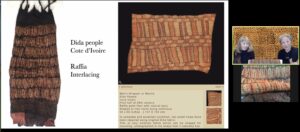
Episode 2: Shibori in Africa: Dida, raffia interlacing & Man’s Wrapper or Mantle, Andres Moraga Collection. Ana Lisa Hedstrom and Yoshiko Iwamoto Wada, 2021.
Preservation & Expression of Craft Cultural Heritages:
In recent years, the preservation of crafts emulates activist expressions for socio-political, equality, and self-identity to encourage community empowerment. Yoshiko and Ana Lisa highlight organizations, artists, and designers who are enriching African craft cultural heritages and integrating crafts with artisans, locals, and institutions. Yvonne Fasinaro, founder of Adara Foundation aims to preserve craft heritages in Nigeria by empowering women and the youth to actively contribute to Africa’s socio-economic development. Danilo Lavisi, curator of Espace Culturel Gacha works in Cameroon assisting its founder, Ly Dumas to promote the awakening of vocations, develop talent and disseminate knowledge.
Chief Nike Davies Okundaye; artist, designer, and founder of Nike Art and Craft Center, is devoted to preserving traditional weaving and dyeing traditions that are the source of her inspiration and are fading in Nigeria. Her international success has launched a cultural revival, bridging arts centers with locals and foreigners.
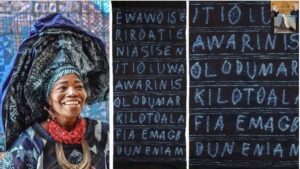
Episode 2: Shibori in Africa: Left: Chief Nike Davies Okundaye. Right: Textile by her grandmother, 1920, raffia hand-tie and hand-stitched, Nigeria.
Gasali Adeyemo, a Master Adire artisan, has studied and taught at Nike Art and Craft Center. Born in Nigeria and now living in the United States, is highly sought after and created collaborative work, in the 2020s with Christina Kim, DOSA.

Episode 2: Shibori in Africa: Left: Gasali Adeymo and Adire Oniko, indigo resist-dyed coton. Right: Gasali Adeymo and his textiles and tools, indigo resist-dyed cotton, stencils, DOSA Collaboration project.
Stephen Hamilton, an American mixed media artist, studied at Nike Art and Craft Center. He incorporates hand-woven or hand-dyed cloths as a canvas and is compelled to integrate textiles with women and mythology as subjects communicating as a powerful visual language. Stephen actively is involved in projects, such as Rocksberry Project.
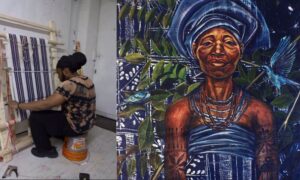
Episode 2: Shibori in Africa: Left: Stephen Hamilton weaving. Right: Stephen Hamilton Iya Mapo, acrylic on Guinea Brocade 45” x 68”. Photo: © Stacey Hamilton.
Meni Mbugha, a Congolese designer currently in the PhD studio art, is studying Japanese paste-resist and shibori with natural dyes at Kyoto City University, in Japan. He synthesizes ancient African patterns with auspicious Japanese symbols in his new designs.
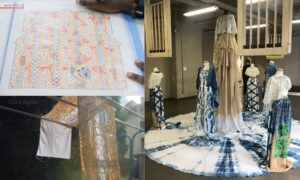
Episode 2: Shibori in Africa: Left: Meni Mbugha designs & textiles 2020, NHK World Japan, Core Kyoto. Right: Meni Mbugha Shibori Katazome, MFA Show, Kyoto City University of the Arts, Japan.
Koko Lingwala, a Congolese Sape (french slang word for “clothes”, meaning ‘dressed up’), is part of a subculture LA SAPE in the DRC and Republic of Congo. The movement first emerged under colonial rule and grew as Congolese soldiers returning from Europe after WWII who brought home the latest Parisian fashion. No longer a subculture, now more spotlight styles, Koko’s performative dance wears his trademark outfits fusing Kuba textiles.
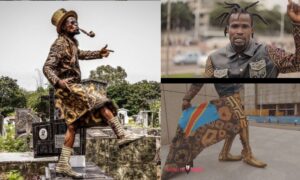
Episode 2: Shibori in Africa: Left: Koko Lingwala Congo’s Sapeurs Revisit Their Roots, Kubo Cloth, performance, video. Photo: © Justin Makangara. Right: Koko Lingwala Minute Sape, Screenshots from video, Kubo Cloth, 23 Jul, 2020.
Through the contributions made in this episode, our eyes are open to see exciting new developments, creative expressions and efforts going on in Africa. We realized that there is so much to learn with so many people and institutions/centers to connect to enrich our life in the West.
Other practitioners mentioned: Catharine Ellis and Sistaaz of the Castle.
- Next Episode 3: India, Indonesia, Cambodia, the Himalayas, China (Southwestern Minority people and Mongolia) on April 21, 2021.
- Register at Slow Fibers Studio.
